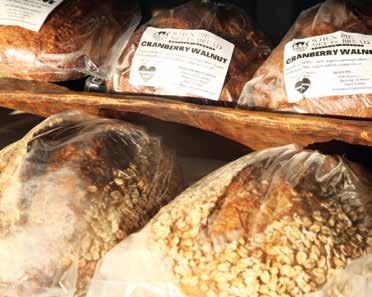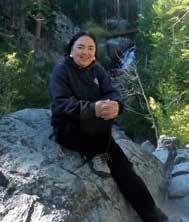THANKFUL & BLESSED
the magazine



























the magazine





























Lema Ranch, home to The McConnell Foundation, is beautiful year-round but the fall is particularly breathtaking. The natural foliage is an everchanging cascade of color that beckons the public to come enjoy a walk on the grounds. We at The McConnell Foundation are grateful to work in this environment and we invite others to enjoy the beauty as well.

T he M c C onnell Found a tion Helping build bet t er c ommunities th rough phila n th ro p y To learn more visit: www.mcconnellfoundation.orgPhoto credit: Robert Estrada
| Glassblowers Jason Paine and Ron Toroni
| Something Unique at Anime Teahouse in Yreka
| A Little History with Etna Brewing Company
| Redding Chess Club
| Water is Life Exhibit at Siskiyou Museum
| My Town: Tristen Aitken
| Recipe: Roasted Brussels Sprouts with Balsamic Vinegar and Honey
Downtown Details
| Enjoy the View: Frank Kratofil
| What’s Cookin’: Market Street Blade and Barrel Turkey Stuffing with Cranberries
| Giving Back: Lakehead Volunteer Fire Company 54
The Return of Cascade Christmas
| Shasta High School Wellness Center, Part Two
| When Pie Meets Bread, A Match Made in Heaven

| 90 Years of Caring for Others with Lim’s Cafe
| Tehama Independent Living Program











Enter to win five tickets to Garden of Lights, a $100 value. Experience a whole new tradition. Create new and lasting memories this year with all the unique colors, sounds and scents of the winter season throughout Turtle Bay’s curated gardens at the Sundial Bridge and the Sacramento River. Walk down winding paths leading through 10 acres of artfully illuminated and immersive displays exhibiting world-class design. Celebrate the natural world with wildlife and plant-themed exhibits unique to our region.
Redding Garden of Lights at Turtle Bay Exploration Park McConnell Arboretum & Botanical Gardens
Nov. 19 - Dec. 31 Wednesday - Sunday, 5 - 9pm
Go to our website, www.EnjoyMagazine.com and enter for your chance to win. One winner will be drawn at random. Drawing will be held the 25th of the month.
Four t-shirts from Visit Redding

YVONNE MAZZOTTA publisher
MICHELLE ADAMS publisher
RONDA ALVEY editor in chief
KERRI REGAN copy editor
CATHERINE HUNT event calendar/website
JAMES MAZZOTTA advertising sales representative/ new business developer/photography
MICHAEL O’BRIEN advertising sales and marketing manager
KEVIN GATES
JEN VERMAAS CONNIE BLANC advertising sales and marketing consultants
NICCO MAZZOTTA BEN ADAMS DIANE MORGON SAGE FULTON MICHAEL KELLY deliveries
JAMES MAZZOTTA store manager
TRINITY ADAMS
MARJAN WHITE CATHERINE HUNT store
www.enjoymagazine.com

1261 Market Street Redding, CA 96001 530.246.4687 office 530.246.2434 fax
Email General/Sales and Advertising information: info@enjoymagazine.com
Kao Saelee, Brittany Shafer, Kai & Sienna Saelee and Romee the dog

Photo by Kara Stewart karastewartphotography.com
©2022 by Enjoy Magazine. All rights reserved. Reproductions without permission are strictly prohibited. Articles and advertisements in Enjoy Magazine do not necessarily reflect the opinions of the management, employees, or freelance writers. Every effort is made to avoid errors, misspellings and omissions. If an error is found, please accept our sincere apologies and notify us of the mistake. The businesses, locations and people mentioned in our articles are solely determined by the editorial staff and are not influenced by advertising.
Enjoy and Enjoy the Store are trademarks of Enjoy, Inc.
Local. Regional. California Made. American Made. ‘tis the season
Looking for that unique and special gift for the Holidays?
From gifts for your family and friends, to corporate gifts for your business clients or employees, Enjoy the Store has something to please every taste.








THE HOLIDAY SEASON provides opportunity for reflection, and we hope that you find yourself feeling content, thankful and blessed, today and always.
If a Thanksgiving feast is part of your plans, we’ve got some recipes that will dazzle your dining companions. Our Roasted Brussels Sprouts with Balsamic Vinegar and Honey will give those boring green beans a run for their money, and our friends at Market Street Blade and Barrel were kind enough to share their savory Turkey Stuffing with Cranberries recipe. If you run out of time to bake pies or rolls, never fear – When Pie Meets Bread in Redding has you covered.

Once the feast is over and you’re looking for something interesting to do, consider a jaunt to Siskiyou County. The “Water is Life” exhibit at Sisson Museum in Mount Shasta tells stories of the success and struggle surrounding the use of this precious resource. Then visit the Anime Teahouse in historic downtown Yreka, which offers custom tea blends and unique gifts, mostly imported from Japan. The owner creates her own spin on the blends she creates by affixing labels with hand-drawn animated characters that represent the personality of each tea.
We’re thrilled to share that “Cascade Christmas” is returning to the historic Cascade Theatre, with the former Mrs. Claus serving as director this time around. It’s a tribute to shows from years gone by, featuring family elements, humor and fun – and the run is just four days, so get your tickets early.
As we count our own blessings here at Enjoy, please know how deeply grateful we are for our readers, advertisers and everyone who makes the magic of this magazine happen every month. We are thankful for each of you!















I never imagined that I would eventually compete as a Heptathlete in college! I was a competitive gymnast up until high school, then played volleyball, tennis, competitive dance, and ran track. My coaches at Shasta College saw my potential and encouraged me to become a Heptathlete. In this two-day, multi-event competition, we compete in seven events: the 100m hurdles, high jump, shot put, 200m, long jump, javelin, and the 800m. However, during my first season, I suffered a major injury leaving me unable to fully walk or run for almost two years. Fortunately, after surgery, I was able to come back stronger and better than I was before.
Thanks to the amazing Shasta College Track & Field head coach, Anthony Williams, and all my other coaches (JP, Ky, DJ, OJ, Ian), I became a two-time Conference Champion, Runner-Up NorCal Heptathlon Champion, and qualified for State, where I finished in the top four in the state, top ten in the Nation, and received All-American status for the Heptathlon. I was also very fortunate to train with the new Shasta College diving coach, Crystal Hilton, who helped me win the Diving Conference Championship on both 1m & 3m, third place on both boards at the NorCal Diving Championships, and qualify for State, where I was able to finish in the top five on 1m and took home an All-American title for Diving.
I’m now competing in Division I Track & Field at CSU Northridge! I feel very blessed to be attending the university, competing in the sport I love, and studying Kinesiology and Pre-Med. I plan to attend medical school and become an Orthopedic Surgeon. I’m extremely thankful for all the opportunities I have been blessed with as a Shasta College Knight!
College is

 Branch Manager, U.S. Bank Board Chair, Shasta Historical Society
Branch Manager, U.S. Bank Board Chair, Shasta Historical Society

Iwas raised in the town of Adin, in Modoc County about 80 miles south of the Oregon border. Growing up in a rural area means I got a real taste of what it means to grow up in a small town. After graduating from Big Valley High School, I packed my things and moved away from the small-town life and set off for college in the big city of Redding. After college, I intended to move back to my hometown and raise my family there. It was an incredible place to grow up and I wanted to give my children the ability to grow up in an area where community mattered.
Fast forward more than 20 years, and this pit stop on the road of life has become my second hometown. Since moving here, I have lived between the City of Shasta Lake and Redding, ultimately settling on the City of Shasta Lake to be where I raise my family. The area provides a small-town feel much like my hometown. We have amazing community events year-round like the Boomtown Festival, Damboree Parade, the Veterans Day Parade, the Christmas Tree lighting and celebration, Friday Night in the Park and so many more.
Redding has its share of events, too, like Kool April Nights, the Freedom Festival, the Art Hunger Summer Gallery and the Lighted Christmas Parade, to name a few. Of course, when I think of our incredible area, I can’t help but think of the beautiful landscape surrounding us, but most importantly, the people who live here. People who bring together these incredible community events and make them possible. Friends and family working every day to make Redding a vibrant community full of history, arts and culture. Citizens who care, working to make Redding a place where anyone and everyone can thrive. Community matters here, and I am grateful to be a part of it.
I have lived my entire adult life in the Redding area. I met my husband here, my children were all born here and now I am now deeply rooted in this place. I do not know if the Redding area will be my forever home, but it will forever be a place I call home.















The best gift we receive during the holiday season is quality time with family. This year, why not enjoy a nostalgic trip with the whole family to your friendly antique dealers? The doors at all the antique shops around Northern California are open.
As you walk the malls and stores, there is always so much to see and talk about. Often reminders of a rich past. The Thanksgiving holiday is a great time to shop for that just-right gift and teach the young ones just what Grandma or Grandpa had fun with at their



all



remind yourself
goodness that surrounds
in the coming season.

















LIZZIE STOXEN had a nice run as Mrs. Claus in the holiday performances of “Cascade Christmas” and she says the best parts were the cast parties after the final show when excited performers would talk about what to add for next year.
This year, as both director and musical director, Stoxen has taken on the task of writing the “Cascade Christmas” script and she’s using those cast party brainstorming sessions for inspiration. “I’m really having fun coming back to those ideas and putting pen to paper,” she says.
The theme this year is coming home; a return to the fundamentals that helped transform “Cascade Christmas” into a cherished holiday tradition. The story’s a work in progress but Stoxen says it will “pay tribute to what ‘Cascade Christmas’ shows were in the past and ushering in the future. There will be family elements, acceptance, humor and fun.”
Stoxen says she’s been bouncing ideas off Jessica Weichman, a professional playwright who has penned previous Christmas shows, and also is getting plenty of help from her choreographer Kristin Lawrence, who has performed as a dancer at previous shows.
“Redding has such an incredible theater community already and there’s no shortage of wonderful productions people can go and see,” Stoxen says. “’Cascade Christmas’ has become such an ingrained part of the Christmas tradition and when it wasn’t able to happen because of COVID, it was really hard for a lot of people.
“I’m hoping to provide a heartwarming, entertaining show that performers can share with an audience that is ready for it.”
People are ready, says Tara Faires, who stepped in to produce “Cascade Christmas” after an earlier planned production had to be canceled. Even before accepting, Faires says she took an informal poll “and a lot of people wanted to see ‘Cascade Christmas.’ It was important to bring it back.”
Aided by costume help from Debbie Goodman and Amanda Hazeleur, Faires says the goal is to “bring back some of the numbers people really loved and add some new traditions.”
Unlike previous productions, there will only be one weekend of performances, with each show scheduled to fit around other holiday happenings like the lighted Christmas parade and the lighting of the downtown Christmas tree.
“This is the first musical where COVID isn’t such a scary thing so we’re hoping to get people in the theater and get people downtown,” Faires says.

Faires also envisions “Cascade Christmas” serving as the start of a new era for the Cascade Theatre, since it coincides with the start of Alex Hauf-Belden’s tenure as managing director of the theatre. The Shasta County native and Chico State graduate most recently worked as the event and production manager for Principia College in southern Illinois. His previous posts include event coordinator for Seattle Center Productions and assistant production manager for Chico Performances at Laxson Auditorium.
“I’m hoping the Christmas show is the first in a new dawning of the Cascade,” Faires says.
“Cascade Christmas” will be performed at 7:30 pm Dec. 1 and 2; at noon on Dec. 3; and at 2 pm Dec. 4. For tickets, visit www.cascadetheatre.org
Jon Lewis is a Redding-based writer with more than 40 years of experience. A longtime San Francisco Giants fan, his interests include golf, fishing and sharing stories about people, places and things. He can be reached at jonpaullewis@ gmail.com.







glass act
A PUFF OF ONE’S OWN BREATH is at the core of every glassblowing piece, and that’s just one aspect of the art form that Jason Paine finds so compelling. Paine, who teaches at Shasta Charter Academy when he isn’t working with molten glass in his Palo Cedro studio, finds that others are equally drawn to glassblowing once they experience it on their own.
“The appeal is limitless. And it’s challenging; that’s what makes it addictive,” Paine says. “I really enjoy exposing people to glassblowing.” He gets that opportunity with his Shasta Charter students and working with customers who schedule two-hour make-your-own-glass experiences.
Ron Toroni, who started working with glass after a 38year career with the U.S. Forest Service, also enjoys sharing the wonders of glassblowing. For several years, he opened his Bella Vista studio to North Woods Discovery School students and volunteered his time to teach the craft to

eighth-graders. Students finished the six-week course by making their own belt buckles.
Toroni was looking for a challenging hobby and he found it in glassblowing. An intensive six-week course at the Pilchuck Glass School in Stanwood, Wash., gave him a solid grasp of the fundamentals. The following 25 years have been filled with lots of experimenting, growth, learning new techniques and the occasional glassshattering setback. Toroni says he loves it all.
Toroni got his son, Adam, involved in glassblowing and the two often work together as a team. Adam’s daughter, Marina, a senior at Cal Poly Humboldt, also has been known to join in the process. Often, Toroni says glassblowing is best performed as a two-person venture with one partner assisting the “lead” glassblower in choreographed moves as glass is repeatedly heated, formed and colored. 4 continued on page 26
Paine, who often works together with Toroni, was introduced to glassblowing in 2007 when he and his wife, Christine, were backpacking through Europe and happened upon the island of Murano near Venice, Italy. Artisans in Murano have a glassblowing lineage that dates back seven centuries; they were the first Europeans to learn how to make glass mirrors and they refined the use of multicolored glass, threads of gold and crystalline glass.
That fateful visit made such an impact on Paine that he taught himself how to blow glass and, 10 years after visiting Murano, he had a glassblowing furnace set up on the roof of his Hong Kong apartment. A year later, that furnace made its way to Palo Cedro when the Paines, now with three kids in tow, returned to the states and continued their teaching careers. Paine describes himself as a self-taught glassblower but he has attended workshops in Tacoma, Wash., at the Corning Museum of Glass in Corning, NY.
Glassblowing itself dates back 2,000 years and is believed to have been invented by Syrian craftsmen. Today, the process typically starts with clear glass pellets that are melted in a furnace at a scorching temperature of 2,025 degrees fahrenheit. The glassblower dips a blowpipe into the molten glass to collect a glob or “gather” of glass and quickly begins the process of shaping the gather and blowing until the desired shape begins to take place. The glass is workable when it is kept at about 900 degrees Fahrenheit, so frequent reheating in a “glory hole” furnace is required.
Finished pieces are placed in a separate kiln and allowed to cool down over a 12-hour period in a process called annealing. It is not unheard of for a glassblower to return to the studio in the morning only to discover a piece has cracked while annealing. Working with glass – a beautiful yet temperamental material – only adds to the challenge, Toroni and Paine agree.
Occasional breakages aside, Paine says glassblowing is gratifying for him because it allows him to work with his hands and at the end of the day, you can see the results of your efforts. Toroni is more succinct when it comes to glassblowing: “It feeds my soul.”
Both glassblowers work on pieces that strike their fancy and occasionally accept commissions. The seasons tend to influence their work, as well. Glass pumpkins in myriad colors and designs are popular in the fall and colorful ornaments become the go-to handblown glass baubles for the holiday season. Their work is available at Enjoy the Store in downtown Redding.•
www.jasonconradglass.com
Ron Toroni, Lassen View Glass (530) 472-3158

Jon Lewis is a Redding-based writer with more than 40 years of experience. A longtime San Francisco Giants fan, his interests include golf, fishing and sharing stories about people, places and things. He can be reached at jonpaullewis@ gmail.com.

“The appeal is limitless. And it’s challenging; that’s what makes it addictive,” Paine says.
“I really enjoy exposing people to glassblowing.”



Drive through
Walk in or curb side delivery

155 Lake Blvd., Redding Mon- Sun 9am- 10pm (530) 215-1430
Find them on Facebook
1335 Market St., Redding Daily 9am-9pm (530) 242-1915

Find them on Facebook
1177 Shasta St., Redding Sun-Th 11am-9pm / Fri-Sat 11am-10pm (530) 247-1110

Find them on Facebook
1636 Market St., Redding Tues-Th 11am-9pm / Fri-Sat 11am-close
Closed Sunday and Monday (530) 246-2190 postofficesaloon.com
4432 Shasta Dam Blvd., Shasta Lake Sun-Th 11am-9pm / Fri-Sat 11am-10pm (530) 275-4455 pizzafactory.com




835 Browning St. B, Redding Daily 10am-9pm (530) 276-8850 jerseymikes.com

1804 Hwy. 273, Anderson Daily 11am-8pm (530) 776-3060
Find them on Facebook
22020 Palo Way, Palo Cedro Daily 8am-1pm (530) 547-4290
Find them on Facebook
3055 Bechelli Lane Tues-Sat 5-9pm / Closed Sunday & Monday (530) 223-1636 nellosrestaurant.net

MOUNT SHASTA’S Sisson Museum is in the middle of an ambitious three-year exploration of the region’s water. The current “Water Is Life” exhibit, which runs through December 12, tells stories of success and struggle as the various stakeholders of the region grapple with who gets to use, and benefit from, this limited resource.
There is, indeed, more demand for water than supply, which has led to the tragedy of decimated populations of fish in the Klamath and Shasta rivers. Over a 60-year period, the population of fall-run Chinook salmon in the





Shasta River dropped from 80,000 to just 586, in part due to irrigation diversions to ranch operations.
Then there are the success stories: Efforts by the Scott River Watershed Council in the Scott Valley to restore beaver populations and their dams along the river have boosted underground water tables and reduced irrigation costs for the ranchers along the river. There is also the heartening story, with Mother Nature as the hero, of the recovery of the Upper Sacramento River after the devastating spill of a toxic weed killer in 1991, just upstream from Dunsmuir. Nineteen-thousand gallons of metam sodium spilled in the water from a derailed train, killing virtually every living thing in a 50-mile stretch of the river all the way to Shasta Dam. But it took the river and its fish little more than a decade to bounce back from this near-death experience and become, once again, a world-class fishery.
Also spotlighted in the exhibit is the increasing role of Native American tribes in determining how water is allocated, particularly as it benefits the region’s fish populations. The Klamath, Karuk and Yurok tribes have been major players in the push to remove four dams on4 continued on page 31




the Klamath to benefit the river’s dwindling salmon populations. The dams’ removal is expected to start by 2024.





The Winnemem Wintu tribe is promoting the idea of a fish “swimway” up a number of creeks in the McCloud River watershed that would allow salmon to bypass Shasta Dam and enter the McCloud River for the first time in more than 80 years.
To promote awareness of the region’s historic salmon runs, the Winnemem and several other tribes stage an annual “Run4Salmon” that follows the age-old route of the salmon from the McCloud and Upper Sacramento rivers to San Francisco Bay. The trek is done on land and water, with tribe members running, cycling and paddling their way on the 300-mile journey.
The exhibit also looks at the impact of global warming, which is causing the gradual melting of Mount Shasta’s glaciers. That, in turn, has caused massive mudslides that have threatened to cut off the town of McCloud’s water supply. The exhibit features dramatic photos of rivers of mud cascading down the mountain’s slopes.
On the positive side, we learn from the exhibit that the town of Mount Shasta is mounting its own campaign to curb global warming by encouraging its residents to get out of their fossil fuel-burning vehicles and walk and bike more.
Some parts of the exhibit are interactive. Museum-goers have an opportunity to respond to questions like “who owns water?” with answers pasted on sticky notes. Sample responses: “no one,” “all of us,” “The Simpsons.”
While this exhibit focuses on the present uses and struggles over water, an earlier exhibit in 2021 focused on the past and Native Americans’ reverence and respect for water as a living thing, contrasted with the early European settlers’ view of it more as a commodity. There were also exhibits on early fish hatcheries that were installed as fish populations declined.
Next year’s exhibit, on the future of the region’s water, will run from April to December and look at the impact of the removal of the Klamath’s dams, the management of groundwater supplies and a series of “storytelling events” that will feature a wide variety of stakeholders talking about their relationship to water and include ranchers, farmers, Native Americans, river rafters and city users.
“Water has been overpromised, and if we continue as we have, there won’t be enough to go around,” notes the museum’s executive director, Rosemary Romero. “At our museum, we want people to talk and learn from each other and work together to figure this out.”
•



Sisson Museum • 1 North Old Stage Road, Mount Shasta Hours: Thursday through Monday, 10am to 4pm • (530) 926-5508









THE SHASTA HIGH SCHOOL Wellness Center held its official grand opening celebration last May – nearly the end of Mental Health Awareness Month, and pretty much the end of the school year – where it was announced that it would be ready to serve students in the fall. Truth is, this testament to community welfare opened the previous fall and served staff, students and their families the entire 2021-22 school year. It wasn’t quite fully furnished and there were wrinkles to iron out, but it promoted wellness – mental and physical.
Makenzie Knighten, then assistant director of the center, calls its first year a soft opening. “We wanted to navigate how to be open,” she explains. “We wanted to provide a place for students who needed help to be able to get out of class for a while. But we didn’t want them to abuse the privilege. Eventually, we restricted the time to 15 minutes for calming – more if needed, of course. Also, our recordkeeping helped identify who came in and often they came in.”
Cindy Lindsay, then director of the center, saw the developing facility as a way to extend the school’s Career Technical Education (CTE) program, which prepares students for a career straight out of high school. As the school’s CTE medical instructor, Lindsay guided her pupils down educational pathways to any of a variety of positions, from sports physical therapist to registered nurse to doctor of medicine. The center provided her a place where CTE partners, medical
professionals who visited with CTE students to mentor, could meet in a professional setting with triage, an examination table and the latest equipment.
From the start, Lindsay saw to it that the kids would run things. “Our unique twist is that it’s student-driven. We facilitate the contact, but we don’t want to do too much. It’s up to them,” she says. “They need to do the research. They need to do the work. If we let them, they will do it in ways we wouldn’t think about.”
From the start, incidentally, doesn’t refer only to Lindsay’s direction of operations after the soft start last year. Her start on the Shasta High School Wellness Center began years earlier, when after a meeting on campus she pitched it to a representative of California’s Value Trust, the school employees’ health care provider.4 continued on page 34
“I saw the opportunity. The district was already working on an expansion of the grant,” she recalls. “It was a scary idea, but the grant fell right into place.” Lindsay wrote that grant, and after it was secured she wrote another, then another, one for each year they were available. Those three Community College Chancellor’s Office Strong Workforce grants would total somewhere near $895,000. In addition, Gov. Gavin Newsom announced a $4.7 billion commitment to increasing California mental health providers and suicide prevention programs. “There are lots of dollars coming down from government now,” Lindsay emphasizes.
Her idea for the center came from back when she was about Assistant Director Knighten’s age now, volunteering in a wellness center at Sacramento State University, where she pursued bachelor’s and master’s degrees in exercise physiology. There she saw the preventative health and wellness model in action. Students treated students – creating exercise plans, managing weight loss diets, scheduling health care symposiums for the community in general.
“I loved it,” she says. “Even after 25 years, all of that stayed with me, and I wanted to do the same kind of thing here. For three or four years, while I was a CTE teacher at Shasta High School, I was also a cardiac nurse at Shasta Regional Medical Center. I saw what happens when you don’t take care of yourself. I wanted to teach them health and wellness, instead of waiting for them to roll in sick.”

As the grant monies came in, Lindsay sought sponsors for further funds, landing CTE partners like Shasta Regional Medical Center and California’s Value Trust. She credits Northern California United Way for buying the center the coffee bar that lines a wall in the spacious wellness room.


When former student Knighten volunteered to help set up the wellness center, Lindsay welcomed her as an old friend. “I’ve known her family for years,” she says. “She had a passion for mental health and wellness. I was still working with the TV videos she made when she was a student.” When she saw what Knighten could do for the center, former teacher hired former student as assistant director.
A few months ago, Shasta High promoted Knighten to wellness center director. As Lindsay transferred to another Shasta Union High School District campus, Knighten offered the following tribute: “The wellness center is a testimony to the time, heart and dedication of Lindsay. She has a tremendous passion for health, wellness and well-being of the students, and this facility would not have existed without her.”
“I am extremely grateful and fortunate to have worked with her for the last two years, and I have seen the change we cultivated together on campus at Shasta High School. I fully intend to grown and expound on the ideas we created together as I take on this new role as the wellness center director.”
•
I WANTED TO TEACH THEM HEALTH AND WELLNESS, INSTEAD OF WAITING FOR THEM TO ROLL IN SICK...
















“I’VE ALWAYS THOUGHT Yreka could use something a little different,” explains Andrea Weary, the owner and visionary behind the Anime Teahouse, a relatively new boutique in the city’s historic downtown that sells custom tea blends and unique gifts imported mostly from Japan. Tucked in a charming little shop full of color and character, Weary was inspired to open based on her love of tea and Japanese anime. “Anime is a general term for a cartoon. When I was young, around 12 or 13, my brother and I would rush home from school to watch it. We couldn’t get enough of it. And ever since then, I’ve been in love with Asian culture. I have a degree in Chinese language in Asian studies from Berkeley and studied Japanese for two years. I lived in China and Taiwan for a couple of years, and then seven years ago I finally moved to Yreka.”
While tea is a staple of the Asian cultures Weary adores, she has created her own spin on the blends she creates by affixing labels with hand-drawn animated characters that

represent the individual personality of the teas. For instance, Weary’s first character was “Lady Green Tea.” She explains, “I love green tea, so as I was drinking it I thought, ‘What type of character would go with this tea?’ I started searching on the internet for different ideas on different anime characters or different manga (Japanese comics) characters that had green hair and captured what I was experiencing.” From there, Weary has developed a wide range of tea offerings and the characters that go along with them. “When I taste each sample, I sit down and think something like, ‘What do I want the character for Lady Chai to look like?’ So I’ll research where chai comes from. India. Then, I’ll look at pictures of women in India, how they dress and everything like that. Then, there’s Lady Black tea. Black tea is very popular in England, so I wanted her to be Victorian.”
on page 38

Oolong Papaya blend is represented by a character Weary calls “Lady Fae” – as in a lady fairy. “The papaya pieces are a kind of yellow color and so in the artwork, you can see her hair is yellow, her clothes are yellow. I thought the tea, the taste, the wonderful smell, it just reminded me of a fairy, and when you drink it, it makes you feel happy and light.”
Weary is something of a character herself, a bubbly blend of enthusiasm and dedication. In addition to weekends running her tea shop, she still works full-time as a teacher for the vision impaired. Even though she sometimes gets tired, she’s living out her long-time dream. “I remember telling my husband, ‘I want to do something else besides just teach.’ And we were thinking of business ideas and I said, ‘You know, I love anime. I love tea.’ And he says, ‘How about an anime tea house?’ I was like, ‘Yeah!’”
Weary admits she was nervous at first. “Yreka is a small town and I didn’t know how people would receive it. And when I first started, some people looked at me like I was crazy. But I pushed some of my friends to try the tea and they’d be like, ‘Oh Andrea, we’re not really tea drinkers.’ But I’d say, ‘You’ve got to try this.’ And they loved it. So, I kept testing it out on them and converted a lot of them. Then, I started doing trade shows and it grew from there.”
Since opening her doors, Weary’s shop has expanded to include tea sets, accessories, unique Japanese gifts and a wide range of stickers, novelties and books, including


beginning language books for those interested in learning Japanese. The unique nature of the shop draws people from as far as Medford and Mount Shasta, who are surprised to learn that a shop like hers exists anywhere in the region. But some of Weary’s favorite clients continue to be the students and teenagers who love anime and drop in frequently. “I can totally relate to them. We talk about the latest anime going on and all the latest manga and they’re like, ‘Oh Andrea, have you read this one?’ And they’ll open up their phone and show me. And they’ll say, ‘Look at her hair, look at her eyes.’ And I spent so many hours doing the same thing as a teen that I know what they mean. And that makes me want to just keep going.”
One day, maybe they’ll get their chance to make their dreams happen, too. •
Peterson is a Chico native who lives in Etna. For nearly two decades she’s written, produced and


content for a variety of television
including the Travel Channel, National
and

at Discover Siskiyou and
She
Siskiyou



JUST AS THE PANDEMIC changed the way we interact with one another, the 2020 Netflix series “The Queen’s Gambit” changed the world of chess. And now businesses are back open, and the world has gone back to normal, but the renewed chess craze has kept alive.

When “The Queen’s Gambit” came out (becoming the number-one watched show in 12 countries), orders of chess sets shot up 87 percent and millions of people joined online sites like Chess.com. In Northern California, the Redding Chess Club has also seen a resurgence, expanding its gatherings to meet twice a week to accommodate the growing number of members.
Redding Chess Club President Matt Rudd has been in the club for more than 10 years. He was born and raised in Redding, but moved around the country a lot before coming back. He took up chess as a hobby while in Kansas, thinking it would be a nice way to meet people and give him something to do.
His cousin taught him to play chess when he was 5 or 6 years old, so he knew the rules, but one day he picked up a book about chess strategy. “And it became more interesting to me,” he says. Rudd started playing with homeless people who hung out on the street corner and got better at it. He soon found a local chess club and went to a meeting with a friend.
“I got clobbered,” he chuckles.
Rudd also joined a chess club in Portland, Ore., before eventually moving back to Redding. In 2010, he saw that there was a chess club meeting at Yaks coffee shop, so he and a friend went to check it out. About 10 to 15 people were playing chess, and he began showing up more regularly. After a few years of being active in the club, Rudd became president.
Rudd says that the Redding Chess Club started in the 1930s or the 1960s, depending on which of its older members you ask (its crest says that it was officially established in 1965).

Sometimes three or four people show up and sometimes the café is full of players. Summertime is slower, when the weather gets nice and people tend to be outside. Predictably, more members show up in the winter when the weather is colder and it’s nice to hunker down indoors with a chess set and an opponent.
Time limits are set on chess games so that they don’t drag on forever (and annoy café workers trying to close).
“It was a change I pushed for becoming president. People would start a game and then the coffee shop would try to kick us out. Each person has their own time; a player makes their move and then hits the button to reset the clock. If the time runs out, they lose,” Rudd explains. This creates a balance and is especially nice for impatient players. The club encourages new players to use clocks as much as possible, unless they are playing a casual game with a friend or someone who they absolutely know plays at the same pace as them.
Five-minute blitz games have also gotten more popular because they’re even more fast-paced and exciting to watch.
Around 15 people show up on an average game night, and about 50 people are active in the club. About 400 people are in the public unofficial Facebook group.
“People have been itching to get out of the house and it’s a good game to connect with people from all walks of life,” Rudd says. “‘The Queen’s Gambit’ sparked a lot of interest. When people called, they’d mention that and say, ‘I started watching that and started thinking about whether there was a chess club in my town.’” He also teaches chess to kids at a local charter school. “A lot of parents call about getting their kids into it,” he says.
Rudd believes he’s played tens of thousands of chess games over the years (possibly even hundreds of thousands) and has won about half of them, or a bit more, if you consider the chess games he’s played against students. “A lot of them are short blitzes. I play online a lot and they generally match you up with people of a4 continued on page 42
similar ability, but I teach new players a lot which gives me a bit of an advantage,” Rudd says.
The Redding Chess Club is growing and is open to all ages and abilities. The youngest members are two girls who are 4 or 5 years old, and another girl who is 6 or 7 can beat many of the adults. Redding Chess Club Treasurer Ellis Martin is 95 years old.
“Chess attracts the older gentlemen; it’s a good activity for them that’s not physically demanding,” he says. He’d like to see the Redding Chess Club expand its children’s membership, too.

The club meets Tuesdays at Sweetspot and Thursdays at the Braided Mane on Hilltop
Drive at 6pm. “We have some tournaments planned out; we want to do them monthly, maybe weekly, and then have a once-per-year big event,” Rudd adds.
When asked what his favorite part of the world of chess is, Rudd responds, “I like that it’s a game of strategy; you don’t lose because you’ve been dealt a bad hand or bad roll of the dice. I’ve also met a lot of cool people over the years, from all walks of life, people I wouldn’t have met normally. I’ve met a lot of amazing people over the years.

“And chess takes 10 minutes to learn the rules, but it takes a lifetime to master.” •
Find Redding Chess Club on Facebook


 Kayla Anderson is a freelance writer, marketer and action sports enthusiast who grew up wakeboarding on Lake Shasta and learning to ski at Mt. Lassen. She holds a bachelor’s degree in journalism from Chico State University and loves to visit her parents in Redding.
Kayla Anderson is a freelance writer, marketer and action sports enthusiast who grew up wakeboarding on Lake Shasta and learning to ski at Mt. Lassen. She holds a bachelor’s degree in journalism from Chico State University and loves to visit her parents in Redding.
“And chess takes 10 minutes to learn the rules, but it takes a lifetime to master.”







ADRIENNE TIRRI-MAUPIN would never have opened a bakery on her own again. She had operated two different pie shops with her daughter Kirsten Crisosto, who’s been making pie crusts since third grade, when Tirri-Maupin would pay her $1 per crust. Since stepping away from those businesses, she felt she had put brick and mortar ownership behind her. Meeting Nathan Maupin, owner of Nathan’s Sourdough, unexpectedly changed her resolve.
Maupin has long been immersed in the culinary world as a sous chef, private chef, prep caterer and butcher, thriving in the environment of constant inventiveness around food. He picked up breadmaking in 2009 when he worked in a restaurant baking dinner rolls. From there, he says, “It became an obsession of mine to master every type of bread, just like cooking every type of dish.” Then he got into sourdough and realized “it’s not something you master very quickly,” but the cyclical process “kind of overtook me.” He became fully enamored by the practice and was eager to learn more. He began selling his bread at farmers markets on the weekends while cooking and working a full-time butcher job simultaneously. Maupin began to sell out of the bread at every market, and soon was making more in sales than he was from his primary sources of income.
Bread became Maupin’s sole focus in 2013 and he stepped away from his other roles. He started attending every event and market to sell his sourdough. At one such market he met his future wife and business partner, Adrienne Tirri-Maupin. She immediately began to support him through friendly advice and offer welcome guidance on business practices, as she had much experience behind her. “I just wanted to help him; he was great to be
around,” she says. They were inseparable from then on and attended every market and event together, their booths side by side, many people assuming they were a combined business. “Everyone thought it was pie and bread, always. It was Nathan’s Sourdough and For the Love of Pie, always together.”
About three years into this unofficial partnership, they showed up to the Roses and Rust Vintage Market in Anderson, and Tirri-Maupin remembers thinking, “This feeling is a love feeling... oh no.” Maupin agrees that he knew something was different then. They got married in January 2020, making official their personal commitment, but their business partnership had begun nearly as soon as they met. When she realized Maupin’s passion for sourdough and overall culinary skill, Tirri-Maupin thought, “He really needs to own a bakery.” She says, “I would 4 continued on page 46
be able to build it and then he would be able to do his art.” She was confident from the beginning that they had to try. “Knowing how good he is in any aspect of food – there wasn’t even a doubt,” she says. She told him, “We’ll make this happen, if this really is what you want to do. Make it or fail, we’re going for it.”
When they heard NorCal Beer and Brew was moving from the space on Churn Creek Road, Tirri-Maupin and Maupin immediately began inquiring. They started paying rent on the building in 2019, a year before they started renovations on the inside. Once the process started in early 2020, it took a year and a half of rocky remodeling work before their soft opening in October of last year. TirriMaupin says, “This whole facility’s been a miracle.” Maupin adds, “I didn’t think we could afford getting this place; it’s so big.” There were many instances that felt miraculous, and Tirri-Maupin credits God for getting them through it. Everything they sell is from scratch, organic whenever possible, and held to a high standard of excellence. The community has been very supportive of the business so far, and they’re thankful for everyone who has come in and tried a cinnamon roll or a slice of sourdough pizza. Maupin bakes all the bread for the shop, a massive job for one person. He explains it’s difficult to find bakers since there’s next to no one in Redding with good baking experience.

Tirri-Maupin had run bakeries before, so she knew she could facilitate and make all the dynamics work, but the spark that Maupin’s creativity brought was what she needed to take the leap again. Because of the building’s large capacity, they both want it to be a community space where other vendors can potentially set up shop and be able to reach a larger group within the community. They have Julia’s Fruit Stand in the building for 6 months out of the year, a huge point of excitement for Tirri-Maupin, who’s anticipating the ability to collaborate with more businesses in the future. And she adds, “the community loves it.” When Pie Meets Bread would love to do cooking classes and sourdough baking classes in the future, as there’s been a lot of interest in both. Coming into a bustling holiday season, they’re encouraging everyone to pre-order their Thanksgiving and Christmas pies as they continue to serve the Redding community. •

Pie Meets Bread
Creek Road, Redding • (530) 215-3002
Monday through Wednesday, 8 am to 5:30 pm;
through Saturday, 8 am to 6 pm;


9 am to 1 pm
Eythana Miller was transplanted to Redding from Montana three years ago and has fallen in love with the area. She’s in her second year at Shasta College, and loves a good literary discussion over a few cups of black tea.

















WITH ARCHAEOLOGICAL EVIDENCE dating back to perhaps more than 13,000 years ago, beer is one of humanity’s oldest drinks. It’s also one of its most popular – third in the world behind water and tea. So, it’s no surprise that it became a viable commercial pursuit. Cut to the era when American pioneers settled in Siskiyou County, the business of brewing was big time. What might be surprising to learn, however, is that what’s likely the oldest brewery label on the West Coast still in operation is now headed by one of its youngest head brew masters. And, despite being born in the year 2000 and having only recently come of age, 22-year-old Andrew Juliusson of the Etna Brewing Company in Scott Valley has already chalked up years of experience. “When I started in the wine industry, I was 18. We had a program that was called sip and spit. You put the wine in your mouth, swirl it around and spit it out. And that’s how legally you can taste wine. The same thing applied when I switched over to the beer world. I came to Etna Brewery in March of 2021, just before I turned 21, and worked as the assistant brewer for about a year and a half. Then, this past January, the previous head brewer left. At the time, I took over operations, but I had to earn the title of head brewer,” recalls Juliusson.
Etna Brewing Company’s history is a huge part of its brand identity. The origins date back to Charles Kappler, a native of Alsace who established his first brewery in Scott Valley in 1868 before moving to Etna (then Etna Mills) in 1872. After a fire destroyed the first facility in 1875, he immediately rebuilt and eventually incorporated it in 1898. He ran the brewery with his three sons, one of whom even traveled to Chicago to learn the most modern methods of brewing. But with the arrival of Prohibition in 1919, the commercial beer business that had sustained the family for nearly 50 years was over. That is, until a group led by a Kappler descendent, Andrew Hurlimann, revived the brand in 1990 and re-opened the historic Etna Brewing Company close to the original site. Hurlimann, an early pioneer of Chico’s microbrew revolution alongside Ken4 continued on page 50

Grossman of Sierra Nevada fame, was eager to bring back the Kappler glory days. “I got acquainted with Ken and brewed with his crew a couple times and started thinking about doing my own thing. When I got out of school and came back up home, I knew about the original Etna brewery and had the family ties through the Jenners and the Kapplers. I was real big on the history. So, after 10 years of home brewing and friends telling me to start a brewery, I ended up talking eight other people into putting up some money and we started on a shoestring budget.”
Now 30 years since its comeback, the brewery is stronger than ever. A few changes in ownership have occurred over the years, but the most recent owners have re-enlisted Hurlimann as a consulting “legacy brewer” in an effort to restore some of the brewery’s most iconic recipes. These days, Hurlimann is affectionately known as “Andrew Senior” while Andrew Juliusson is called “Junior.” For Juliusson, working alongside Hurlimann is an exciting chance to honor the history while making things fresh. “I have absolutely no ego in the beer world. And I know there are 10,000 more things I have to learn. When I came to the brewery, it was me and Senior making beer while they looked for a new head brewer. In the meantime, I learned his method of brewing and they gave me free range on our seasonal beers. And after it all worked out, they gave me freedom to build the recipes as I wanted.” For Hurlimann, his affinity for Junior is mutual. “It was a natural fit right from the start. I like him. We have the same warped sense of humor.”
After taking over as head brewer, Juliusson confirms that the brewery is still doing all of the classic favorites, but he still leaves plenty of time and energy for seasonal experimentation. “I’m going to be using some new advanced hop products that I got my hands on and we’ll be experimenting with some brand-new stuff. Granted, we’re still going to keep to our roots in our core beers, but it’s always fun to play on the side.” Lance Banks, director of marketing for the Etna Brewing Company, reveals that some of the experimentation will be some custom brewing. “We’ve actually got an upcoming partnership with the Mount Shasta Ski Park where we’ll be doing a signature double IPA for them.”
When asked what makes a good beer, Juliusson is thoughtful. “It’s all subjective. But, when a new batch rolls out, Senior and I drink it together and either say it’s a damn good beer or it’s not. And, at the end of the day, you have to believe in the product you’re putting out.” Senior is a man of fewer words. “If I drink a beer and I want a second one, that’s a good beer.”

Brewing Company
467-5277
131 Callahan St.,
Etnabrewing.com

Megan Peterson is a Chico native who lives in Etna. For nearly two decades she’s written, produced and pitched content for a variety of television networks, including the Travel Channel, National Geographic and Discovery. She works at Discover Siskiyou and considers Siskiyou her muse.










CHICKEN, RICE AND a small vegetable scoop - you know how it is. The new chef filled only half the plate. “No!” May Lim scooped a generous helping of vegetables. She zeroed in on his eyes. “Feed your customers, and they’ll feed you!” The new chef understood. Stay loyal to the customer.
“It went something like this,” Jeanie says with a laugh, the image still fresh in her mind even after 40 years: the scolded new hire and May (Jeanie’s mother) holding the ladle with fire in her eyes.
“Generations of families grew up on our food,” Jeanie says. This was the guiding principle through all 90 years of the restaurant’s career: Feed your customers - they’ll feed you.
Lim’s Cafe just closed – the oldest restaurant in Redding, family-owned since its opening day. The restaurant, a staple of the City of Redding for generations. Its story, one of perseverance, hard work, hospitality and celebration of family.

Founder Peter Lim was sold at age 4 or 5, in the early in 1910s. This is not the typical upbringing of restaurant owners today. Peter was sold into a family who took care of him, but from a young age, he wanted better for his children. A true entrepreneur, Peter arrived in America in 1924 and began work at a restaurant in Red Bluff. Eventually he purchased a Redding restaurant called Kim Sing. He renamed it Lim’s Cafe, and a Lim ran it ever since. 4 continued on page 54

90 YEARS OF CARING FOR OTHERS WITH LIM'S RESTAURANT
Briefly returning to China in 1932, Peter married May (the one with the wooden ladle). Due to the Chinese Exclusionary Act and World War II, May could not officially emigrate to the United States for another 14 years. Week after week, Peter sent money to his bride in China and worked for his future family to have a better life in Redding. When Peter and May finally united in California, the couple worked hard, sponsoring the emigration of May’s family, creating brighter opportunities for many more than just themselves. Peter and May’s children grew up hard-working and happy. They helped their parents work long restaurant hours and continued the legacy of Lim’s. Jeanie remembers growing up in old Redding. “Everyone knew everyone’s names, and there were no chains, no fast food, nothing like that.”
Redding has expanded over the years, but that family feel – everyone looking out for everyone – remains deeply embedded within Redding’s culture, and was preserved inside Lim’s Cafe. The leather booths at Lim’s saw Redding kids grow up and return again and again, eventually with children of their own.

“It’s the same menu that my father used,” Jeanie says of the menu that lasted through the restaurant’s last day. The cafe was laid out in the style of a 1950s retro diner, with both an American and a Cantonese food menu. “That’s the way they did it back then.” In the ‘50s, American Chinese food did not exist. There was Chinese food and there was American food, always two menus. Lim’s was known for both. Locals would come to Lim’s to find the best American-style steak sandwiches. It was said to be the only restaurant where American food ingredients were fresh.
The restaurant announced its closing on August 30, and just two days later, locals were reminiscing. At a Chamber of Commerce meeting on September 1, a local businessman stood up and took a moment to honor Lim’s. Back in the 1930s, most restaurants did not allow dogs or Native Americans. But this businessman remembered his family telling a different story with Lim’s. Lim’s Cafe always welcomed Native Americans. Today, even after its closing, Lim’s Cafe remains an emblem of the city, representing the importance of family and community for Redding. They fed all their customers, and that’s why they kept coming back. •
Ben LoCascio writes children’s curriculum at HeartSmart TV. His senior thesis was awarded highest distinction and an enthusiastic Zoom wave at Brandeis University. It was COVID. Ben lives in Redding, and you can find him in front of any nearby espresso machines, thinking about having just one more cappuccino.

Jeanie remembers growing up in old Redding.
“ Everyone knew everyone’s names, and there were no chains, no fast food, nothing like that.”





















Craft Fair

It’s always time for ice cream!

SOFT SERVE SCOOPED ICE CREAM COFFEE AND ESPRESSO BLENDED DRINKS
4th Street, Orland (530) 988 3055
Ponci’s Welding & Machine Shop


Thank you for your business this past year.
Happy Holidays from Leonand the Crew!
1030 Railroad Ave., Orland (530) 865-2138

Our beautiful and spacious Art Gallery with state of the art lighting offers a wide variety of monthly exhibits featuring quality fine art, by artists from all over the western states.
The First Friday of each month,

us for our Special Presentations from 7 to 9 p.m. or attend our Artists Receptions from 3 to 7p.m. with live music performed on our beautiful baby grand piano.

Regular gallery hours: Tuesdays through Saturdays 12 noon to 5 p.m.
Fourth Street, in downtown Orland
For more information visit our website: www.orlandartcenter.com














Anheuser-Busch, Michelob Ultra® Light Beer, St. Louis, MO 95 calories, 2.6g carbs, 0.6g protein and 0.0g fat, per 12 oz.























AT SOME POINT in recent history, “adulting” became a word. Used as a verb, someone might congratulate themselves for adulting when they take some responsibility like paying a bill or getting a job. It’s a verb because there’s a lot to do as an adult. One must take action.
A young person can count themselves lucky to have a parent or teacher guide them toward adulthood by teaching them how to successfully adult. Otherwise, how is one to know how to fill out a job application, apply for financial aid for college, or set a bill schedule when setting off to live away from home for the first time?
For young people in foster care, adulting can feel even more daunting than for most. A deterioration in the biological family has removed them from their first teachers. Changes in placements may hamper consistency in a foster home.
In Tehama County, a relocated drop-in service center has been created to meet the needs of foster youth in a welcoming way. “It’s more user friendly,” says Janine Labue, coordinator of the Tehama Independent Living Program, now in the heart of downtown Red Bluff. Serving around 45 foster youth, the newly organized center offers snacks, a computer lab, video games and an art cave for creative pursuits. Furnished by a grant from the Tehama Community Action Agency, the center is teen-friendly and inviting.
It is also a repository of support and information for youth to transition into adulthood. “It’s federally mandated to teach life skills,” says Labue, noting that topics can range from health and safety to driver’s education to choosing a college or career path. The program4 continued on page 62
participates in the FAFSA Challenge to make sure students complete their applications for federal student aid for college, and takes them on college visits four times a year. This year they will go north to Cal Poly Humboldt and south to UC Berkeley’s Day on the Green.
One of the biggest services is to support youth in finding and keeping transitional housing. “The youth chooses the transitional housing program,” says Labue. The Independent Living Program makes sure they know all of their options so that decision is right for their individualized needs.

“Food shortage has been a big thing,” she adds, noting that caseworkers support youth in getting CalFresh benefits and finding supplemental food assistance as needed. The center itself is a place for refreshments, where youth can relax safely and enjoy snacks.

“This has really mended my heart,” Labue says of her decision to take this position. “I love helping these youth.” She originally found her place in the world of foster care as a foster parent. “I had a friend
A diabetes diagnosis can feel like both a threat to your health and to your way of life. Managing diabetes means making changes to your day-to-day routine. Getting into the habit of monitoring your blood sugars and finding physical activity you enjoy may feel overwhelming. Additionally, figuring out what to eat can feel like a hassle that you don’t have time for.
Three ways to start feeling your best include regular movement, a balanced eating pattern and adequate hydration with unsweetened fluids. Start with 5 minutes of biking, dancing, chair exercises, swimming or walking, and work up to 30 minutes per day, 5 days per week. This meets the exercise recommendations from the American Diabetes Association. You can even break up the activity to 10 minutes, 3 times per day. However, ANY amount of activity you can do is beneficial. Be kind to yourself if it has been a while since you have been active. Baby steps are usually the best way to achieve bigger goals.
Staying hydrated will help you think clearly and improve your energy levels. Aim for mostly unsweetened fluids like tea, coffee, milk, non-dairy milks, vegetable juices, sparkling water and water with flavorings like fruit, vegetable or herbs added for flavor. Pay attention to what temperature of fluids you like
best. As a general rule, aim for eight, 8-oz servings daily though your needs may vary depending upon the weather, level of activity and health conditions. Nourish yourself with regular meals and snacks containing protein, unsaturated fat, and fiber rich food sources. This typically helps you to avoid a blood sugar spike keeping you satiated and prevents crashing associated with eating a high carbohydrate meal. Protein, unsaturated fat, and fiber examples include tacos on a corn tortilla with lean beef, cabbage, salsa and avocado, or salmon with wild rice and a side of sauteed vegetables in olive oil. When changing your eating pattern, be sure to include the foods you like, ones that are important to you culturally, and don’t be afraid to try something new.
Try not to face your diabetes diagnosis all alone. The right support from others helps us to be more optimistic, happy, and successful. Find out your local options for diabetes related support including walking groups, support groups and educational classes. If you desire personalized medical support, ask your provider for a referral to a Registered Dietitian, Nutritionist (RD/ RDN) or a Certified Diabetes Care and Education Specialist (CDCES) for a thorough assessment and individualized plan.
“This has really mended my heart,”Labue says of her decision to take this position. “I love helping these youth.”
who always had these little kids in tow,” she says of her initial awareness of the need for foster parents. When she became one herself, she says, “I took babies, so I always got really attached.” She later supervised visitation between youth in foster care and their biological parents before transitioning to her current position.
Youth arrive at the program through referral from Tehama County Social Services. They are screened for eligibility and work with a case manager to determine their goals. While meetings are mandated just once a month, the drop-in resource center encourages more frequent participation and supports a closer bond between staff and young people.
“We make a plan,” Labue says of the work at the Independent Living Program. With a plan being a key component of Adulting 101, it’s a critical component of helping youth leave foster care to safe, healthy, productive lives on their own. Having a safe place to start the plan makes all the difference in turning a plan to action.•
Melissa Mendonca is a graduate of San Francisco State and Tulane universities. She’s a lover of airports and road trips and believes in mentoring and service to create communities everyone can enjoy. Her favorite words are rebar, wanderlust and change.
Family Practice Pediatrics

Medical Facilities
Dental Facilities
Medical transport within Plumas and Tehama Counties
Community Health Representatives
Indian Child Welfare Worker
When it comes to diabetes management, it’s all about finding the right balance and support that works for you. Make Greenville Rancheria a part of your diabetes healthcare team. You can call (530) 528-8600 and ask to speak to a Community Health Representative regarding our Greenville Rancheria Diabetes Talking Circle.
We will be celebrating world Diabetes Day on Monday November 14, 2022

Diabetes Services
Mental Health Services Drug, Alcohol and Family Counselor Addiction and Medication-Assisted Treatment

8 Sub-specialties:
Women’s Health, Internal Medicine, Orthopedics, Physical Therapy, Psychiatry, Cardiology, Pulmonology and Pain Management

Open for Walk-ins. 8am – 5pm. Medical - Dental Monday - Saturday 8am-5pm
Call clinics first to confirm hours of operation due to the COVID-19 pandemic. Now our Red Bluff and Greenville Dental is open










WE GET IT: Brussels sprouts are not everybody’s favorite vegetable. Many of us grew up with these pungent mini-cabbages on the kitchen table and attempted everything to avoid eating them. In many households, it held the status of the veggie that kids disdained the most.
In fact, according to a 2008 research study, Brussels sprouts were named the most-hated vegetable in America – beating out spinach and lima beans. But just six years later, the nutrition-rich cruciferous veggie was considered one of the hottest food trends in America.
These days, Brussels sprouts are more popular than ever. And it’s easy to understand why. These little balls are jam-packed with healthy goodness:
• A rich source of vitamins A, B1, B2, B5, B6, C, E, H and K.
• Contains potassium, magnesium, calcium and zinc, as well as healthy protein and carbohydrates.
• A natural source of folic acid.
• The antioxidants strengthen immunity, support the respiratory system, help the digestive and cardiovascular systems, and have anti-inflammatory properties.
• Improves the condition of the skin, hair, and nails.
• Speeds up the treatment of infections. And if prepared correctly, Brussels sprouts are delicious. Roasting is an easy and tasty way to
prepare most vegetables. All vegetables have a small amount of naturally occurring sugar; roasting at high temperature caramelizes those sugars and causes chemical reactions that reduce bitter flavors. Modern Brussels sprouts have a mellower, nuttier flavor profile with a less bitter aftertaste.
Believe it or not, scientists have bred Brussels sprouts to taste better. In the 1990s, Dutch researchers identified what made these veggies bitter. Seed companies in the Netherlands began searching through their extensive collections of older varieties of Brussels sprouts for ones that had a lower concentration of glucosinolates. So if you hated them as a child, you owe it to yourself to give Brussels sprouts another try.
For many families, Thanksgiving is a potluck affair. The host prepares the main entrée (traditionally turkey, stuffing, mashed potatoes and gravy), while the guests bring appetizers, side dishes or dessert. This year, be bold and bring this delicious Brussels sprouts recipe, featuring balsamic vinegar and honey.
You may get a look of dismay from the children’s table (and probably a few grownups). Don’t let the naysayers deter you –chances are you will convert a few family members.
You can prepare the dish the day before and reheat them the day of the feast. No need to crowd into the host’s kitchen and interrupt the main attraction.




Small Business Saturday is an American shopping holiday held the Saturday after Thanksgiving during one of the busiest shopping periods of the year. This is always the last Saturday in November, so this year’s Small Business Saturday is November 26.
First observed in the United States in 2010, Small Business Saturday is a counterpart to Black Friday and Cyber Monday, which feature big-box retail and e-commerce stores. By contrast, Small Business Saturday encourages holiday shoppers to patronize businesses that are small and local.

The first event was created by American Express, in partnership with the National Trust for Historic Preservation, Boston Mayor Thomas M. Menino, and Roslindale Village Main Street. In 2010, the holiday was promoted via a nationwide radio and television advertising campaign. American Express bought advertising inventory on Facebook, which it in turn gave to its small merchant account holders to promote the event.
The idea of Small Business Saturday grew quickly. In 2011, the U.S. Senate passed a resolution to support Small Business Saturday, and participation has since expanded to all 50 states. Consumers spent an estimated $23 billion shopping on Small Business Saturday in 2020.
The main goal of this event is to give small businesses a revenue boost during the holiday shopping season. Local spending is also good for a town’s economy. More than 67 cents of every dollar spent at a small business stays in the local economy. By shopping small, local consumers can help boost businesses in our own backyard and promote a healthier local economy.

If you’re a gamer, you’ll want to check out Redding VR – the premiere virtual reality experience in Redding. They specialize in creating a fun and entertaining gaming area for all ages. Play from their Steam library on their two gaming PCs or any of their four VR stations. Try on their Valve Index, Vive Pro, Vive Cosmos or Oculus S Rift. Bring your own computer and connect to their network, or simply use your Steam account on their PCs
track
achievements and progress.

This year, Viva Downtown, in partnership with downtown businesses and the Redding Chamber of Commerce, is encouraging a big push for Small Business Saturday. Supporting local was a major theme during the pandemic. Though life has mostly gone back to normal, brick and mortar shops, restaurants and local makers are not seeing the same type of support they did when pandemic restrictions were at their highest. These local shops are still here and need our business more than ever to continue serving our community. This Small Business Saturday, November 26, make your way to Downtown Redding for a Market Street Markers Market with your Downtown Passport, and experience exciting opportunities to support Downtown businesses. Who knows, Viva Downtown and the Redding Chamber may even supply you with a Small Business Saturday tote bag for your contributions. Check out www. vivadowntownredding.org/small-business-saturday for more information and events happening on Small Business Saturday. We hope to see you Downtown, support local year-round!
Anthem’s Body Arts opened as Nathan’s Anthems Tattoos on September 30, 2004 in Shervan Square on the corner of Market and Tehama Streets in Downtown Redding. They view their profession as an art form and with great reverence. The employees hired by Anthem’s are personable, professional, have good ethics and a great value system. The shop is clean and comfortable. The artists listen, ask questions and make your experience everything you hoped for.
1358 Market St • Redding anthemsbodyart.com • (530) 241-8288






Frank Kratofil enjoys spending time with his family, friends and patients and he enjoys time in the outdoors. As a young man, Frank was legally blind. Two successful corneal transplants encouraged him to photograph the magic in nature... beautiful colors and the delicate balance of nature, animals and humans. Find him on Instagram @frankkratofil



Tired of the same old stuffing? Our friends from Market Street Blade and Barrel have have kindly shared their recipe for Turkey Stuffing with Cranberries, and if you add this to your holiday feast, you may find yourself assigned to bring stuffing for every Thanksgiving moving forward. Enjoy!

8 cups stuffing croutons
2 large carrots
6 stalks of celery
2 medium yellow onions
2 leeks
6 cloves of garlic
2 medium shallots
2 T Herbs de Provence
6 sage leaves (fresh)
6 thyme sprigs (fresh)
¼ cup bacon fat (any fat, oil or butter will work as a substitute)
2 eggs 1 to 2 turkey necks
1 bag of giblets (should come with the turkey)
1½ cups of sun-dried cranberries
1 orange
T powdered sugar
cups water
T sherry
wine Salt and pepper
DIRECTIONS:
Cranberries: Zest orange, then cut in half and juice. Mix with powdered sugar and sun-dried cranberries. Add to last cup of water, set aside to plump, about 2 hours.
Making the Mirepoix: Peel carrots and onions, then medium-dice carrots, celery and onions. Smalldice garlic and shallots, split leeks in half, then slice into thin half-rings. Put everything in a bowl and set aside, leaving the garlic aside.
Making Turkey Stock: In a small saucepan, melt 1 T of bacon fat on high heat. Add one third of the garlic and the turkey neck(s), whole. Let brown for 1-2 minutes. Then add one-third of the mirepoix. Let cook until the onions start to soften and caramelize, 3-4 minutes, using a wooden spoon stir occasionally. Don’t let anything stick to the pan. Deglaze the pan with white wine, add half of the sage and thyme, then add 2 cups of water. Reduce heat to a simmer. Cook until turkey neck meat is falling off the bone, about 2 hours. Strain the stock through a colander and put back in pan. Pull out the turkey neck(s), set aside to shred later.
Making the Stuffing: Pre-heat oven to 350 degrees. Chop giblets and shred all the meat off the turkey neck(s). In a large saute or cast iron pan on high heat, add bacon fat. After fat has
melted add the remainder of garlic, giblets and sherry, and season with salt and pepper. Cook until browned. Add in remaining mirepoix and cook until tender. Chop up remaining sage, pull thyme leaves from stems and add to pan. In a large bowl add croutons with 2 eggs and Herbs de Provence. Drain cranberries and mix w/ croutons. Add mirepoix, giblets and shredded turkey to crouton mix. Mix in half of the turkey stock and season with salt and pepper to taste. Put in oven-friendly pan or casserole dish. Add remaining stock as needed, make sure it’s generously moist without getting loose.
Cover with parchment paper and wrap with foil. Bake for 30 minutes. Uncover and return to oven for 12 to 15 minutes, or until golden brown. Pull out, let sit for 10 minutes and enjoy.
*Next Level. For a more homemade approach, you can make your own croutons. I use sourdough baguette chopped into cubes of any desired size. Toss in melted butter, olive oil, Herbs de Provence, granulated garlic, salt and pepper. On a sheet pan, toast in the oven at 350 degrees for 10 minutes. Remove pan, stir contents, bake again for 2-4 minutes, or until golden brown. Then remove from oven and let them air cool/dry overnight.
Simplify. For a simpler approach use a store-bought stock and skip step 2. Turkey, chicken or vegetable all work.
Come into Enjoy the Store in Redding each month and ask for your FREE recipe card.
The Shasta County Veterans Service Office serves more than 9,000 veterans every year, who need affordable transportation to get to work, school, and medical appointments.


RABA supports these local veterans and will match you 50 cents for each $1 donation.
Donations can also be made online today at RABAVeterans.com

by:







































THIS MONTH, Enjoy spoke with CAL FIRE’s Scott Corn, assistant chief of the Shasta-Trinity Unit’s Central Division, about the Lakehead Volunteer Fire Company 54 and its vital role in the community.
ENJOY: What is the history of Lakehead Volunteer Fire Company 54?
CORN: The fire station was built in 1973 by the citizens of Lakehead and was known as the Shasta Lake Volunteer Fire Department. It had a total of 30 active members. In the early 1990s, the fire department came under the administration of the Shasta County Fire Department and its name changed to the Lakehead Volunteer Fire Company 54.
ENJOY: Despite a robust history, didn’t the fire company briefly close in 2017?
CORN: Yes, the station closed after a long-term dedicated volunteer retired. The decline in volunteerism has been felt statewide by many fire agencies over the last five to eight years. This is due, in part, to the increased training requirements, an economy requiring citizens to work two jobs or longer hours, and a lack of time to dedicate to volunteerism.
ENJOY: Absent volunteers, did CAL FIRE have a Plan B for fire protection in that region?
CORN: Yes. In the interim, CAL FIRE responded to Lakehead from the Shasta College station. Mountain Gate Fire Protection District also responded to the community of Lakehead as the closest resource under a mutual aid request.
ENJOY: What if Lakehead Volunteer Fire Company 54 had not re-opened?
CORN: The impact of a closed Lakehead station would be significant to the community. The closest first responders and fire apparatus would be more than 20 minutes away and this community would have one of the longest wait times for emergency response, up to 20 to 30 minutes.
ENJOY: What about the effect on neighboring fire units tasked with responding to Lakehead?
CORN: In the past, the impacts were born upon operating budgets for fuel and personnel time. The calls for service also meant that the outside responding agencies were not readily available for calls in their own areas or districts, and mutual aid from other departments to respond behind them was required.
ENJOY: So, investment was high to resurrect Lakehead Volunteer Fire Company 54?
CORN: Yes. Lakehead is a small community that displays pride and the willingness to work together to achieve better emergency response. Many community members have stepped forward with their efforts, time and financial backing.
ENJOY: What changes has CAL FIRE made to better sustain Lakehead Volunteer Fire Company 54’s operation?
CORN: The Shasta County Fire Department implemented a reserve firefighter program, enabling any Shasta County Fire Department volunteer member within Shasta County to sign up for volunteer station coverage ranging from 12- to 24-hour shifts at the Lakehead Fire Station. These reserve firefighters are paid a shift stipend to stay at the station and respond immediately to any emergency call.
ENJOY: Does the stipend solve the volunteer challenge?
CORN: The stipend is one of the highest in the state and helps, but does not remedy the situation. A large pool of volunteers to draw from and a sense of volunteerism is still required. The program is also designed for those volunteering who wish to add to their work experience/resume for entry into a paid department.

ENJOY: How many firefighters currently serve Lakehead Volunteer Fire Company 54? What’s the desired number?
CORN: Four currently; ideally, around 20.
ENJOY: What is CAL FIRE’s vision for Company 54?
CORN: Moving into the future, the reserve firefighter program will be a priority, along with the securing of a more permanent level of service in the community. Our end state goal is a consistent and robust emergency response delivered to the residents within the Shasta County Fire Department’s jurisdiction. •
Find Lakehead Volunteer Fire Company on Facebook (530) 238-2129
Claudia Mosby is a Redding-based freelance writer. She is the founder and director of The Expressive Spirit, a wellness company in Mt. Shasta offering spiritual direction, arts and nature-based activities and consultancy for grief and loss.
 LAKEHEAD VOLUNTEER
LAKEHEAD VOLUNTEER





1261 Market Street Redding, CA 96001
Downtown Redding 475 Knollcrest Dr. Redding, CA 96002
Phone: (877) 319-7222
Mon-Fri 7:00 am – 4:30 pm
Redding on Cypress 100 E Cypress Ave. Redding, CA 96002
Phone: (877) 319-7222
Mon-Thu 8:00 am – 4:30 pm

Fri 8:00 am – 3:00 pm
(Closed for lunch 1:00 to 2:00 pm)
Anderson 3082 McMurry Dr. Anderson, CA 96007
Phone: (877) 319-7222
Mon-Thu 8:00 am – 4:30 pm (Closed for lunch 12:30 to 1:30 pm)
Eureka 2440 23rd St. Eureka, CA 95501
Phone: (707) 240-4224
Mon-Thu 7:00 am – 6:00 pm


